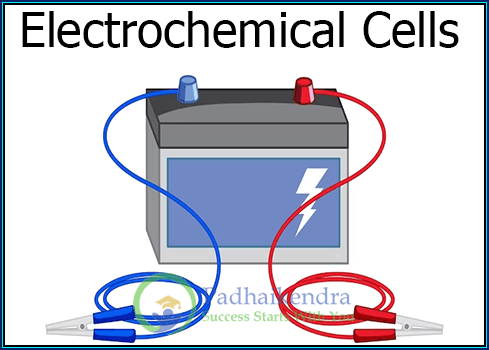What are Electrochemical Cells?
Electrochemical cells are devices that convert chemical energy into electrical energy by using a redox reaction. In these cells, a spontaneous redox reaction is used to produce a flow of electrons, which can be used as electrical energy.
Half-cell and Cell Potential

| Half-Cell | Cell Potential |
|---|---|
| Consists of only one electrode and one electrolyte | Consists of two half-cells, each with its own electrode and electrolyte |
| Measures the electrode potential of a single electrode | Measures the potential difference between two electrodes |
| Used to determine the direction and feasibility of a redox reaction | Used to determine the voltage of an electrochemical cell |
| The potential is measured against a standard reference electrode, such as the hydrogen electrode | The potential is measured using a voltmeter that measures the potential difference between the two half-cells |
| The potential is measured in volts (V) or millivolts (mV) | The potential is also measured in volts |
Types of Electrochemical Cells

| Type of Electrochemical Cell | Description | Examples |
|---|---|---|
| Galvanic cell | Uses a spontaneous redox reaction to generate electrical energy | Batteries used in electronic devices, such as laptops, cell phones, and cameras |
| Electrolytic cell | Requires an external source of electrical energy to drive a non-spontaneous redox reaction | Electroplating of metals, such as gold and silver, onto jewelry and other objects |
| Fuel cell | Converts the energy of a fuel, such as hydrogen, into electrical energy | Used in electric cars and other vehicles |
| Photoelectrochemical cell | Uses sunlight to generate electrical energy through a photochemical reaction | Used in solar cells and other renewable energy technologies |
Applications of Electrochemical Cells
Electrochemical cells have various applications in different fields. Some of the significant applications of electrochemical cells are:
 Batteries: Electrochemical cells are used in batteries to provide a portable source of electrical energy for electronic devices, such as cell phones, laptops, cameras, and flashlights. These batteries use galvanic cells to generate electrical energy through a redox reaction.
Batteries: Electrochemical cells are used in batteries to provide a portable source of electrical energy for electronic devices, such as cell phones, laptops, cameras, and flashlights. These batteries use galvanic cells to generate electrical energy through a redox reaction.- Corrosion protection: Electrochemical cells can be used for corrosion protection. In this application, the electrochemical cell is designed to provide a protective current that prevents metal corrosion by reducing the anodic reaction rate.
- Electroplating: Electrochemical cells are used in electroplating to deposit a thin layer of metal onto a substrate. In this application, an electrolytic cell is used, where a non-spontaneous redox reaction is driven by an external source of electrical energy.
- Fuel cells: Electrochemical cells are used in fuel cells to convert the energy of a fuel, such as hydrogen, into electrical energy. Fuel cells are commonly used in electric vehicles and other applications that require a clean and sustainable source of energy.
- Sensors: Electrochemical cells are used in sensors to measure the concentration of certain chemicals, such as oxygen and carbon dioxide. These sensors use a redox reaction to generate an electrical signal that is proportional to the concentration of the chemical being measured.
- Medical applications: Electrochemical cells are used in medical applications, such as pacemakers, to provide a source of electrical energy for implanted medical devices. In this application, batteries are used to power the device, which delivers electrical signals to the heart to regulate its rhythm.
Electrochemical cells have various applications in different fields, ranging from batteries for electronic devices to sustainable and clean sources of energy in fuel cells. The versatility and flexibility of electrochemical cells make them essential in developing new technologies that can benefit the environment and the economy.
Electrochemical Cells FAQs
An electrochemical cell is a device that converts chemical energy into electrical energy by using the spontaneous redox reaction between two different electrodes.
The two types of electrochemical cells are galvanic cells (also known as voltaic cells) and electrolytic cells.
In a galvanic cell, a spontaneous redox reaction generates a flow of electrons from the anode to the cathode, which can be used to power an external circuit.
In an electrolytic cell, an external source of electrical energy is used to drive a non-spontaneous redox reaction, causing a flow of electrons from the cathode to the anode.
Electrochemical cells are commonly used in batteries, fuel cells, electroplating, and corrosion protection.
Electrode potential is a measure of the ability of an electrode to gain or lose electrons. It is measured relative to a standard hydrogen electrode (SHE) under standard conditions.
The Nernst equation relates the electrode potential of a cell to the concentrations of the reactants and products involved in the redox reaction.
The potential of an electrochemical cell can be controlled by adjusting the concentrations of the reactants and products, the temperature, or the external voltage applied to the cell.
The choice of electrolyte can affect the performance of an electrochemical cell by affecting the rate of the redox reaction, the concentration of the reactants and products, and the potential of the electrodes.
Advantages of electrochemical cells include high energy density, long lifespan, and low environmental impact. Disadvantages include the cost of materials, the need for proper disposal of spent batteries, and the risk of fire or explosion in some types of batteries.


 Batteries: Electrochemical cells are used in batteries to provide a portable source of electrical energy for electronic devices, such as cell phones, laptops, cameras, and flashlights. These batteries use galvanic cells to generate electrical energy through a redox reaction.
Batteries: Electrochemical cells are used in batteries to provide a portable source of electrical energy for electronic devices, such as cell phones, laptops, cameras, and flashlights. These batteries use galvanic cells to generate electrical energy through a redox reaction.


